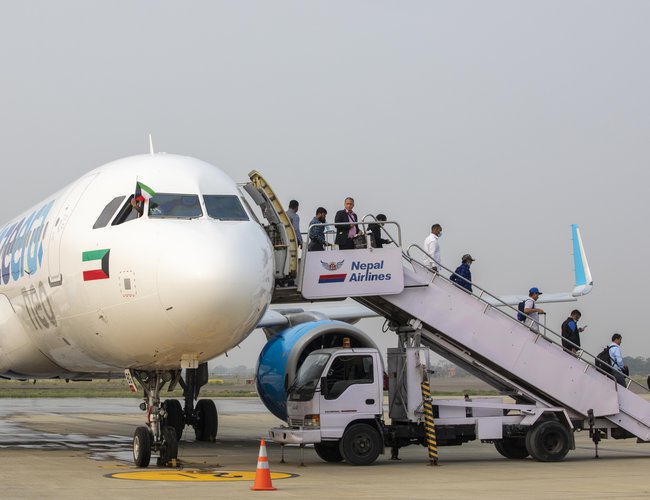
As an Airbus 320 of Jazeera Airways landed carrying over 60 Nepalese, most of them foreign workers, at GBIA at 7:07 am on 16 May 2022, the birthplace of Gautam Buddha got formally connected to the world by air.
Located in the central Tarai, GBIA has been envisaged as the international gateway to Lumbini, the birthplace of the Buddha, located 18km from Bhairahawa.
The total cost of the airport construction is $76.1 million, excluding land acquisition. Out of this, the Asian Development Bank contributed $37 million in loans and grants, while the OPEC (Organization of the Petroleum Exporting Countries) Fund for International Development contributed about $11 million in loans. According to the project, Rs. 28 billion was spent to acquire the land at the construction site.
Constructed under ADB’s South Asia Tourism Infrastructure Development Project, GBIA is helping Bangladesh, India, and Nepal improve infrastructure and services in key tourism sites.
With 3,000-metre-long and 45-meter-wide runway, the airport will be a game-changer. At a time when only a few tourists are traveling to Lumbini due to the connectivity issue, the airport provides Buddhist religious tourists to land directly at Bhairahawa.
The airport also helps connect Lumbini to the Buddhist Circuit in India, namely, Bodh Gaya in Bihar, Sarnath in Benares, and Kushinagar in Uttar Pradesh.
Gautam Buddha was born in Nepal and Bodh Gaya, Sarnath and Kushinagar are important for his enlightenment, his first sermon and attainment of Mahaparinirvana respectively.
Apart from promoting tourism and connecting to the Buddhist circuit, the GBIA is expected to expand trade and economic activities, generate local employment and address the air traffic congestion at the TIA.
GBIA Inauguration
Prime Minister of Nepal Sher Bahadur Deuba inaugurated Nepal’s second international airport, the Gautam Buddha International Airport (GBIA), supported by the Asian Development Bank (ADB). The opening was marked by a successful landing of an international commercial flight.
PM Deuba said the opening of the airport is a historic day in Nepal’s aviation and tourism sectors and will contribute to the country’s overall development and prosperity in the long run.
On the occasion, the PM said that the opening of GBIA has created the foundation for the nation's tourism and sustainable economic development, expressing the belief that tourist arrivals will increase with this.
Home Minister Bal Krishna Khand said the Gautam Buddha Airport will support promoting tourism in a big way. He shared that although the construction of the airport was delayed to some extent due to the COVID-19 pandemic; it is successfully constructed through joint efforts from all sides.
Minister for Culture, Tourism and Civil Aviation Prem Bahadur Ale expressed that Nepal's message of peace and prosperity would be spread across the world from the land of the Buddha. He said GBIA is one among the five national pride projects to be completed, adding that the country's tourism and economic development would take a stride after the completion of all these five projects under the Ministry of Tourism.
Civil Aviation Authority of Nepal (CAAN) director-general Pradeep Adhikari said GBIA will be an alternative to TIA with the operation of international flights.
He further added that the operation of GBIA has put to an end the compulsion of having to divert airplanes to the neighboring countries in situations when aircraft could not land or take off from TIA due to technical problems. He said that the process of construction of the terminal building under the second phase would be forwarded soon.
Speaking at the inaugural event, ADB Country Director for Nepal Arnaud Cauchois congratulated the Government of Nepal on the completion and opening of the airport despite the challenges posed by the pandemic. “The airport will help connect Lumbini—a major tourist and pilgrimage destination—to Buddhist circuits in South Asia as well as to the rest of the world. In a broader context, the airport will form a cornerstone of the country’s overall development by facilitating tourism, expanding trade and economic activities, generating local employment opportunities, and improving international air transport access to migrant workers and people living in the nearby provinces.”
High Expectations
With the inauguration of the airport, there are high expectations from the GBIA in transforming the economy of Lumbini, Karnali, and Sudurpaschim. Entrepreneurs and locals anticipate a big boost to tourism with more airlines expected to start direct flights to the airport.
Lumbini, which is a center stage of Buddhism, has remained no more than an extension of the Indian Buddhist Circuit package, with visitors slipping in through the border to spend only a few hours at the Buddha's birthplace.
For the migrant workers from Terai, this airport provides an easy alternative to fly. The opening of the GBIA gives them the alternative to fly from or to Bhairahawa.
The GBIA holds much promise for Nepal's overall economic development and progress. However, it is up to the authorities and the entrepreneurs to plan their operations and businesses properly so as to make the most of the airport.
For Bhairahawa-based tourism entrepreneurs, traders and migrant workers, the construction of the airport is a historic event and symbolizes the effort to decentralize development across the country.
“We had to travel to the capital city for each and every task. Now this compulsion has ended,” said Chandra Prakash Shrestha, president of the Siddhartha Hotel Association. “The development of the airport is an immense accomplishment. The doors to rapid development have opened.”
Development means creating jobs and economic opportunities, according to Shrestha. “We should generate jobs and stop people from going abroad. We are aspiring for these things to happen,” an elated Shrestha told a newspaper.
According to Siddhartha Hotel Association, there are 5,000 rooms available now and an additional 2,500 are under construction. Half a dozen five-star hotels are in the planning phase and a few are already operational including Hotel Pawan.
Gautam Buddha International Airport located in south-central Nepal is a 280-km drive from Kathmandu. Surya Prasad Khanal, an entrepreneur in United Arab Emirates, is happy to fly to Dubai from near to his hometown.
Khanal lives in Nawalparasi, 35 km from the airport, and travels frequently to Dubai in the United Arab Emirates where he owns a restaurant named Silver Spoon.
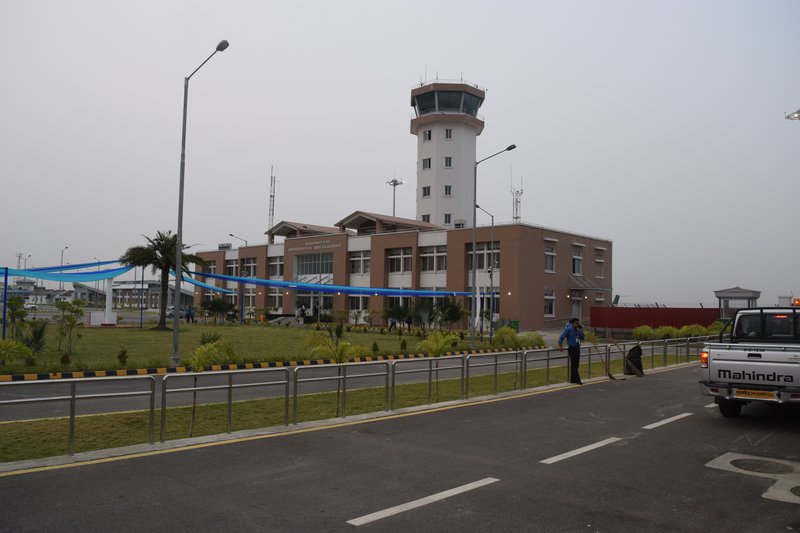
“The airport saves both time and cost,” said Khanal before boarding the inaugural flight. The Dubai-based Nepali restaurateur, who has been doing business abroad for 25 years, said it was a proud moment to see international flights landing in Bhairahawa.
“We are very happy to have the international airport close to home,” said Riyazullal Musalman, a migrant worker from Kapilvastu who boarded the first flight from the Gautam Buddha International Airport to Doha, Qatar on Jazeera Airways of Kuwait.
“Instead of taking more than 14 hours journey and staying overnight in hotel in Kathmandu, I came here on my motorbike,” said Musalman. “The airport is just an hour’s drive from my home. “
Before the Gautam Buddha International Airport, Khanal and Riyazullal had to travel to Kathmandu and spend a night there before flying abroad.
“The operation of the second international airport is a milestone in Nepal’s tourism sector. The will bring a lot of economic benefits to western regions particularly in the tourism sector,” said Chandra Prasad Dhakal, senior vice President of Federation of Nepalese Chamber of Commerce and Industry. “ This is a major a major support of Asian Development Bank and I would like to thank ADB on behalf of Private sector,” said Dhakal.
As Nepal is in the process of political transformation form unitary state to federal, the operation of airport is a major shift ending the monopoly of Kathmandu for international flights.
Conceived in 2009 following the approval of Asian Development Bank’s board under the South Asia Tourism Infrastructure Development Project to develop and improve tourism infrastructure in Nepal, GBIA has gone through upheaval in several ways.
Awarding the contract to upgrade the Bhairahawa airport into an international airport to a Chinese company in October 2014, the project was slated to be completed by the end of 2017. At one time, the project entered nearly to a stage of cancellation, but Asian Development Bank saved it, realizing the complexities.
From earthquake of 2015, trade disruption with India, dispute with contractor, stone quarrying and finally the COVID-19, GBIA has gone through all kinds of disaster faced by Nepal delaying it by at least three to four years. However, Nepal has now an infrastructure which has changed its aviation history.
“Despite many hassles, we are very proud to see it happening,” said Arnaud Cauchois, the Asian Development Bank's country director for Nepal.
“In a broader context, the airport will form a cornerstone of the country’s overall development by facilitating tourism, expanding trade and economic activities, generating local employment opportunities, and improving international air transport access to migrant workers and people living in nearby provinces,” added Cauchois.
“It's the beginning. We would like to see more airlines joining the Gautam Buddha International Airport in the near future,” said Cauchois.
Lumbini In Boom
Just after the beginning of the construction of GBIA, investors have started to invest in Lumbini. Economic activities have been booming in Bhairahawa with opening of new hotels.
Nepal’s renowned hoteliers and former president of Hotel Association Nepal Yogendra Shakya is coming with new investment proposal. The Rs5-billion Hub Lumbini scheme is a tourism destination development project that amalgamates hospitality and housing.
“The Hub is a project to entice the foreign tourists coming via India, who drive back the same day, to spend some money in Lumbini and help the Nepali economy,” said Shakya, owner of the Nagarkot-based Club Himalaya resort and Hotel Ambassador in Kathmandu. “We are quite aware that our investments are risk-taking and long-term; but we are confident that if we can do it on the barren hills of Nagarkot, we can do it on the fertile grounds of Lumbini.” Shakya told The Kathmandu Post.
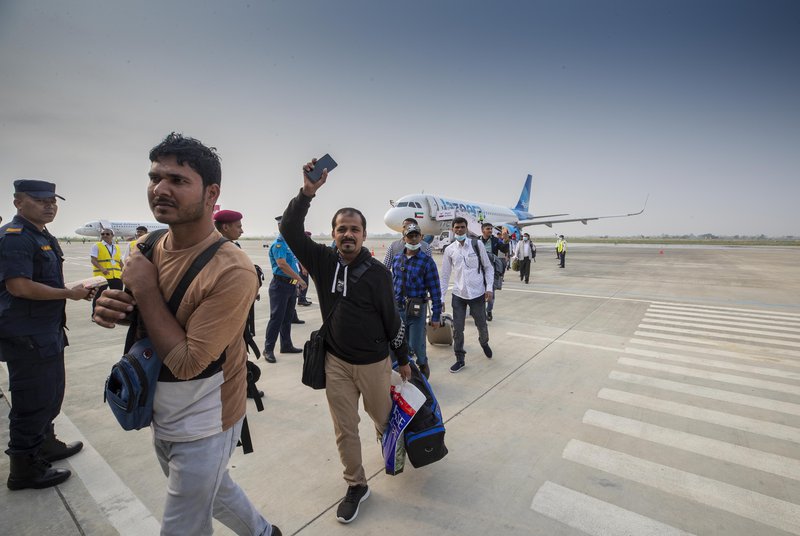
“In spite of the many hurdles not only due to the pandemic, but slow government permit, we are crusading forward with the new project in Bhairahawa,” said Sakya, former president of Hotel Association Nepal.
Despite many challenges including the air route issue with India, GBIA is now a reality and operational second international airport of Nepal.
Tourism Minister Prem Bahadur Ale said during the inauguration of the new airport that he was hopeful India would give access to new entry points to facilitate Nepal’s air connectivity.
“The opening of the airport is a moment of pride for the country. Nepal’s second international airport will serve as an alternative to the Tribhuvan International Airport in Kathmandu, and airlines will no longer have to divert to other countries in the event of bad weather or other technical issues,” he said.
In a separate event in Lumbini, in the context of official inauguration and commencement of commercial operation of the Gautam Buddha International Airport, Prime Minister Deuba highlighted that the airport will further facilitate connectivity, cultural linkages, and people-to-people movements and promotes cultural tourism, according to a statement issued by the Foreign Ministry.
“The opening of the airport is an historic day in Nepal’s aviation and tourism sectors,” said Deuba, “and it will contribute to the country’s overall development and prosperity in the long run.
India Is First To Use GBIA
Nepalese media mentioned Indian prime minister skipping the GBIA citing the reason of the issue of air route and Indian media wrote that PM Modi avoided the use of GBIA citing the Chinese investment for the project. Based on fake information about GBIA, which is constructed under the investment of ADB and OPEC, Indian media tried to damage the project.
Nepalese media speculated about the views and opinions of PM Narendra Modi and Indian media harped on fake information regarding Chinese investment. Reality was different.
Actually, it was Indian Air Force Plane which was the first aircraft to use the GBIA for carrying necessary supportive equipment to PM Modi’s visit.
Handling a wide-body aircraft of NAC successfully, GBIA shows that cargo can be operated from there. Indian Air Force’s Illusion aircraft IC-76 is second bigger aircraft to land at GBIA.
A special plane, belonging to the Indian Air Force, landed at GBIA on May 11 carrying a team of 30 Indian military officials to make the necessary security arrangements for Indian Prime Minister Narendra Modi who came to Lumbini on May 16 on the occasion of Buddha Jayanti. The plane also brought a vehicle that Prime Minister Modi would use during his visit here, according to reports.
GBIA spokesperson Shyam Kishor Sah informed that the Indian Air Force’s Illusion aircraft IC-76 came twice to Bhairahawa from Delhi via Kathmandu to drop and pick up necessary security related equipment to prepare for Modi’s visit.
Regional Project
This is a part of overall regional project. Main objective of the project is to improve tourism. This is a part of Buddhist circuit linking the shrines of Bangladesh, India and Nepal to improve connectivity and develop basic facility to attract quality tourism.
In India this project was implemented in state of Sikkim. Similarly, it was implemented to improve Buddhist tourist infrastructure in Bangladesh but also other religious sites of Hindu and Muslim.
In case of Nepal, the project started with the connectivity and improvement of some of the basic facilities within Lumbini. GBIA is the major part of the project. Development-wise, Lumbini Development Trust area is more important but fund-wise GBIA is the major component.
“Inauguration of the airport is a milestone. This project will benefit the migrant workers and tourists and local people. Many people do not to have to go to Kathmandu to catch the international flights,” said the ADB’s Country Director.
“We are very proud of what is happening now. This airport will not only improve the connectivity but also boost the tourism in this Buddhist circuit connecting Bangladesh and India. The airport will also attract pilgrimage tourists from Sri Lanka, Japan and Southeast Asia. Hotels have been mushrooming in this region generating employment.
Built with the support from Asian Development Bank, the GBIA is going to be not only a major game changer in Nepal’s aviation sector but also a harbinger of a new era for federalization.
For the last half century, Asian Development Bank has been providing all kinds of support to Nepal to improve and build infrastructures in drinking water, electricity, road, schools, health and other livelihood related projects.
“To date, ADB has committed 488 public sector loans, grants, and technical assistance totaling of $7.4 billion to Nepal. Cumulative loan and grant disbursement to Nepal amount to $4.68 billion.”
As Nepal is trying to recover from the COVID-19 Pandemic, ADB support is highly important for Nepal in infrastructure, improving access to basic services and protecting the poor and vulnerable.
A Milestone In Nepal’s Aviation And Tourism Sectors
By Arnaud Cauchois
It is a great honor for me to participate in the inauguration of the Gautam Buddha International Airport by the Prime Minister.
On behalf of the Asian Development Bank, I would like to congratulate the Government of Nepal for the completion of this project and its opening on the auspicious day of Buddha Purnima.
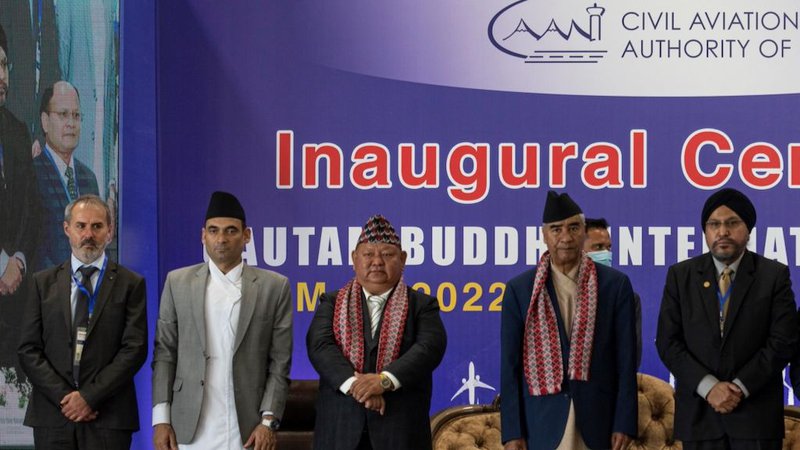
The opening of the airport is a milestone in Nepal’s aviation and tourism sectors. I would also like to offer my sincere appreciation and congratulations to Civil Aviation Authority of Nepal, the project team, contractors and consultants in successfully completing the project under the leadership of the Ministry of Culture, Tourism and Civil Aviation. I would especially like to acknowledge Minister Ale who has worked relentlessly to make this day a reality.
We are very happy to see that with the persistent efforts of all stakeholders, this critical infrastructure project is completed and now set for operation despite the challenges posed by the COVID-19 pandemic and that in itself is something to be proud of.
Direct air connections will help bring in more visitors to Lumbini and surrounding areas and connect Lumbini to Buddhist circuit in South Asia as well as rest of the world. On a broader context, the airport will form a cornerstone of the country’s overall development by expanding economic activities across countless sectors: tourism, hospitality, transport, trade, to name but a few, generating local employment opportunities, and improving international air transport access to migrant workers and people living in the nearby provinces.
ADB, as Nepal’s long-standing development partner, is proud to have supported the Government of Nepal in this national pride project.
ADB is committed to continue supporting Nepal in its green, resilient, and inclusive recovery from the pandemic to achieve high and sustainable economic growth, improve the lives of Nepali people and build resilience to climate change impact.
Once again, my heartiest congratulations to the Government of Nepal and everyone involved in the successful opening of the airport.
And thank you to the organizers for your kind invitation to this historic event this morning and for your gracious hospitality.
(Arnaud Cauchois is the Country Director of Asian Development Bank’s Residence Mission In Kathmandu. Excerpts of the remarks delivered at the Inauguration of Gautam Buddha International Airport in Bhairawa.)
GBIA Will Be A Game Changer: Dhakal
Having invested in tourism infrastructures including cable cars in Butwal, CHANDRA PRASAD DHAKAL, Senior vice president Of the Federation of Nepalese Chamber of Commerce and Industry, see the opening of Gautam Buddha International Airport (GBIA) is going to be a major game-changer in tourism promotion and other activities in Nepal. After attending the inauguration of the GBIA, Dhakal spoke to New Spotlight on various issues related to GBIA and its implication for the Nepalese economy. Excerpts
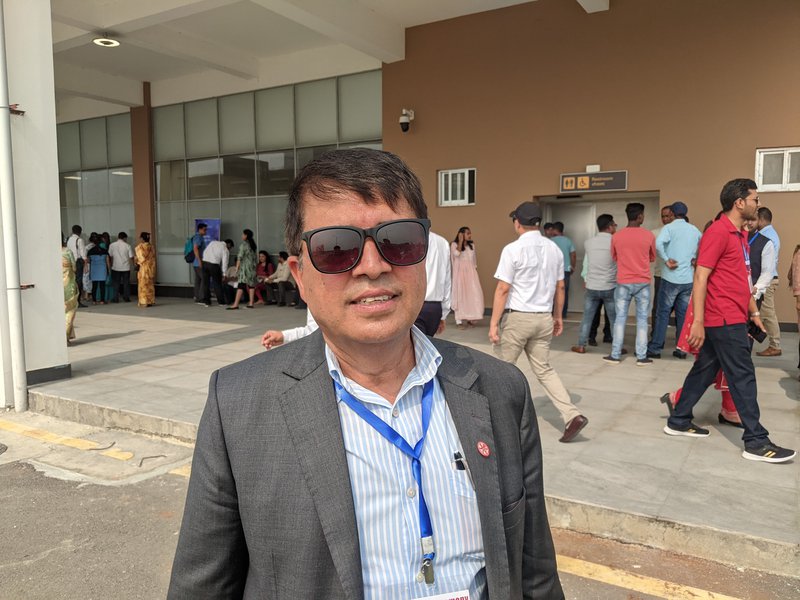
How do you view the opening of GBIA?
This is a historic event for the country because this is the second international airport constructed over the span of 73 years. This will bring a lot of economic and other changes in the western part of Nepal. Opening of this airport is at the right time as Nepalese tourism industries have been passing through a critical time due to COVID-19 Pandemic. The operation of the second international airport is a milestone in Nepal’s tourism sector. The will bring a lot of economic benefits to western regions particularly in the tourism sector. This is a major a major support of Asian Development Bank and I would like to thank ADB on behalf of Private sector.
As a senior vice president of FNCCI and an industrialist, how do you see its economic impact?
This will immensely contribute to accelerating the economic activities in western Nepal through tourism. The airport, which is close to Lumbini, the birthplace of Buddha and Buddha circuits, will likely increase the number of tourists visiting the region. Apart from this, the migrant workers will also get benefits. We can also handle big cargo here as well helping to boost our export industry here.
How do you see the investment in the tourism sector in the region?
With the opening of airports, more tourism industrialists will come to invest in the tourism sector like hotels and recreation centers to attract tourists. The opening of the airport boosts the morale of hoteliers who have already started the operation of hotels.
Have your group invested here in the tourism sector?
We are developing recreation facilities along with cable car in Butwal, which is 20 kilometers from the airport. If more flights start coming and the number of tourists increases, it will also benefit our venture.
How private sector can cooperate with Civil Aviation Authority Nepal to make the airport viable?
It is a greater interest of private parties to make the airport more busy bringing a large number of tourists here. Industrialists have already invested billions of rupees to construct the hotels and other tourism-related activities generating a large number of employment opportunities here. We want collaboration and partnership with the government to make Lumbini as a big tourism hub. This is in the interest of all of us. The government must use the Public-Private Partnership model here.

Keshab Poudel
Poudel is the editor of New Spotlight Magazine.
- ETFC Nepal is focused on expanding distribution and transmission to the private sector: ETFC Chair Dr. Dhital
- Jul 05, 2025
- FOURTH PROFESSOR Y.N. KHANAL LECTURE: Nepal-China Relations
- Jun 23, 2025
- Colonel JP CROSS: Centenary Birthday
- Jun 23, 2025
- REEEP-GREEN: Empowering Communities with MEP
- Jun 16, 2025
- BEEN: Retrofitted For Green
- May 28, 2025















